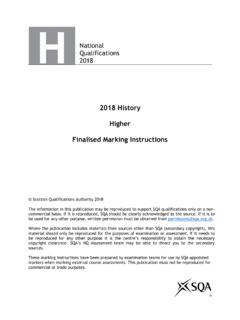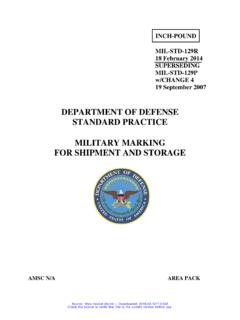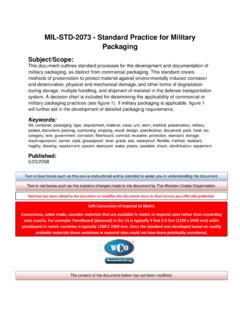Transcription of FM 21-30
1 FM 21-30 military Hieroglyphs and Abbreviations This is an essential reference, but reproducing and editing it is a colossal pain in the gazoo. There is no useful facsimile online (that I have been able to discover) because existing PDF format copies in the various archives are all in black and white. Since much of the information, particularly in the map symbols chapters, rely on color, a lot of information is hidden in the PDF's. Reproducing this copy required days of scan, cut, and paste. The result is worth it for serious living historians. Obviously, only the most ambitious and dedicated will have a need for more than a fraction of the information in the manual (hydrographic conventions, for example, have little application); but as we use military symbols on overlays and maps and sketches, we have a handy reference.
2 1 2 3 WAR DEPARTMENT, WASHINGTON 25, D. C., 28 March 1944. FM 21-30 , Conventional Signs, military Symbols, An Abbreviations, is published for the information and guidance of all concerned. [ (30 Apr 44).] BY ORDER OF THE SECRETARY OF WAR: G. C. MARSHALL, Chief of Staff. OFFICIAL: J. A. ULIO, Major General, The Adjutant General. DISTRIBUTION: B and H (5) ; R (10) ; Bn (5) ; 1 (10) ; C (10). For explanation of symbols see FM 21-6. 4 TABLE OF CONTENTS Paragraphs PART I. General Mapping. CHAPTER 1. CHAPTER 2. CHAPTER 3. CHAPTER 4. CHAPTER 5.
3 CHAPTER 6. SECTION General .. Primary topographic symbols.. Hydrography.. Aeronautical chart symbols.. Works of man.. General mapping abbreviations.. I. Topographic abbreviations.. II. Abbreviations used with hydrographic symbols.. 1-6 7 8 9 10 11 12-20 PART II. CHAPTER 7. CHAPTER 8. CHAPTER 9. military Mapping Symbols. military units.. military activities.. Illustrations of military symbols.. 21-22 23-25 26-27 PART III. CHAPTER 10. APPENDIX. military Abbreviations. List of military abbreviations.. List of references 28-30 LIST OF CHARTS Chart 1. Marginal data for maps, photographs, and aerial photographs.. 3 2. Drainage.. 4 3. Relief.. 7 4. Land classification.. 9 5. Hydrography, dangers, obstructions.. 12 6. Aids to navigation.
4 15 7. Aeronautical chart symbols.. 17 8. Roads, railroads, wire communication.. 21 9. River works.. 23 10. Buildings, urban areas.. 25 11. Miscellaneous.. 26 12. Boundaries, marks, and monuments.. 27 13. military units identification.. 36 14. military units size.. 38 15. Air activities.. 39 16. Antiaircraft artillery activities.. 43 17. Boundaries and delimited areas.. 44 18. Chemical warfare activities.. 46 19. Engineer symbols.. 50 20. Field and permanent fortifications.. 50 21. Obstacles.. 52 5 22. Signal facilities.. 55 23. Special buildings, posts, and centers.. 56 24. Supply, transportation, traffic.. 57 25. Weapons.. 60 26. Examples Antiaircraft Artillery.. 64 27. Examples Armored.. 65 28. Examples Army Air Forces.
5 66 29. Examples Cavalry.. 67 30. Examples Chemical Warfare Service.. 68 31. Examples Coast Artillery Corps.. 68 32. Examples Corps of Engineers.. 69 33. Examples Field Artillery.. 70 34. Examples Infantry.. 71 35. Examples Medical Department.. 72 36. Examples Ordnance Department.. 73 37. Examples Quartermaster Corps.. 74 38. Examples Signal Corps.. 75 39. Examples Tank Destroyer.. 76 40. Examples Transportation Corps.. 77 6 This manual supersedes FM 21-30 , 26 November 1941, including C 1, 9 May 1942 and C 2, 27 July 1942. PART I GENERAL MAPPING CHAPTER 1 GENERAL 1. PURPOSE. This manual gives in convenient form the abbreviations and general symbols which have been authorized for military use.
6 It contains technical symbols and instructions for the' map maker, and military symbols for the use of those in the military service. Persons engaged in the, preparation of maps should also be guided by AR 300-15, TM 5-230, and Bulletin 788, Topographical Instructions of the United States Geological Survey. Those whose duties require them to read foreign topographic and military maps should consult FM 30-22. Symbols other than those shown herein may be used provided they do not conflict with any authorized symbols and are explained in a legend. 2. SCOPE. Part I of this manual deals with general topographic, hydrographic, and air navigational symbols and abbreviations prescribed for use on all United States maps.
7 Part II contains symbols of a military nature authorized by the War Department. Part III gives authorized military abbreviations. 3. SIZE. a. In general, topographical symbols resemble the objects which they represent. The symbols vary in size with the scale of the map. On small-scale maps, the symbols are reduced to their most elementary form and do not conform to scale. As the scale is increased, the symbols assume more nearly the shape and scaled size of the object represented. b. The symbols in this book are generally of a size suitable for use on a map of scale 1: 62,500, unless otherwise noted. 7 4. COLOR. The symbols are shown in appropriate color for a four-color map. When less than four colors are used, the colors in the symbols shown in chapters 2, 3, and 5 which are not used will be executed in black ink.
8 5. LETTERING. Civil divisions are indicated by VERTICAL ROMAN type; natural water features by SLANT ROMAN type, or italic; natural land features by VERTICAL GOTHIC type; and works of man by SLANT GOTHIC type. On hastily prepared military maps, the lettering may vary considerably from these standards. 6. MARGINAL DATA. The data, shown on chart 1 are given, where practicable, in the margins of all maps, photomaps, or aerial photographs, and usually in the places indicated by the encircled figures. On military maps, overlays, and field sketches, only essential information concerning the kind of map, orientation, date of preparation, source, and scale are shown, and then not necessarily in the margins.
9 For detailed information on marking aerial photographs see FM 30-21. 8 9 CHAPTER 2 PRIMARY TOPOGRAPHIC SYMBOLS 7. GENERAL. This chapter gives the symbols used on United States maps for drainage, relief, and land classification. For topographic abbreviations, see chapter 6. Perennial stream (large) .. Perennial stream (small) .. Intermittent stream.. Stream with wash. Dark blue line indicates limit of permanent stream. Brown wash symbol indicates size of normal maximum channel. Intermittent stream in interior of wash will be shown if no permanent stream exists. Anastomosing of braided stream.. Chart 2. Drainage. An intermittent stream is sometimes full, sometimes dry, depending on the season and local rainfall.
10 Anastomosing streams run in multiple channels that reconnect in a braided pattern. 10 Falls and rapids large scale map.. Falls and rapids small scale map.. Waterhole.. Probable drainage, unsurveyed.. Lakes and ponds (permanent).. Lakes and ponds (intermittent) .. Lake or pond (dry bed) and claypans (with appropriate text) .. Lakes and pans (salt-permanent) .. Chart 2. Drainage Continued. 11 Lakes and ponds (salt-intermittent) .. Lakes and ponds (salt-dry)(saltpans) (with appropriate text) .. Spring.. Wells and water tanks.. Glaciers, form lines showing flow.. Glacial surface moraine.. Snow field.. Chart 2. Drainage Continued. 12 Contours (blue if under water) .. Contours (approximate only) .. Form lines (no definite interval).





